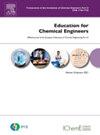平等对待工程学生,但不平等对待他们:探索顶点工程设计项目的多评估者悖论
IF 2.3
2区 教育学
Q1 EDUCATION, SCIENTIFIC DISCIPLINES
引用次数: 0
摘要
在工程课程中,最终的顶点项目与(尽可能)真实的环境中的日常实践相联系,以测试和准备学生在资本密集型化学工程领域的职业生涯。本文探讨了使用顶点工程设计项目进行体验式教学的一个特殊方面:对学生在公司的实际工作进行考试和评估。这些项目既复杂又多样;因此,这些项目的绩效评价往往特别复杂。这些项目通常不能很好地符合单一的绩效标准或准则,因此,预期会有一定程度的评估者之间的偏差。通过对个别设计项目的定性评估进行内容分析,我们发现了一个现象,我们称之为设计项目的多重评估者悖论。这一现象认为,从统计学上讲,这些项目的所有审查员对这些项目的评分基本上是相似的,即最终和子类别的评分都没有显著的年级间偏差。然而,与此同时,这些分数的口头动机在考官之间差别很大,即使有结构化的标准来支持他们的评估。使用计算文本分析(CTA),我们研究了这一迄今未记载的现象,并为其存在提供了可能的解释。我们质疑这种现象的存在是否对教育质量有害,并提出管理这些后果的建议。本文章由计算机程序翻译,如有差异,请以英文原文为准。
Treating engineering students equally without treating them equally: exploring the multi-evaluator paradox of a capstone engineering design project
In engineering curricula, a final capstone project connects to daily practice in an (as much as possible) authentic setting, to test and prepare students for careers in the capital-intensive chemical engineering field. This paper examines a particular aspect of using capstone engineering design projects for experiential teaching: examination and evaluation of students’ practical work in firms. Such projects are as diverse as they are complex; therefore, performance evaluations of these projects tend to be particularly complicated. These projects do not typically correspond well to a singular set of performance criteria or rubrics, and therefore, a degree of inter-evaluator bias is to be expected. Drawing on a content analysis of the qualitative evaluations of individual design projects, completed by several cohorts of graduates of an engineering program, we uncover a phenomenon, which we call the multi-evaluator paradox of design projects. This phenomenon holds that statistically speaking, all examiners of these projects grade these projects essentially similarly, i.e. there is no significant inter-grader bias of both final and sub-category grades. Simultaneously, however, the verbal motivations of these grades vary greatly between examiners, even when there are structured rubrics underpinning their assessments. Using Computational Text Analysis (CTA), we examine this thus-far undocumented phenomenon and offer possible explanations for its existence. We question whether the existence of this phenomenon is detrimental to educational quality, and we provide suggestions for managing these consequences.
求助全文
通过发布文献求助,成功后即可免费获取论文全文。
去求助
来源期刊

Education for Chemical Engineers
Multiple-
CiteScore
8.80
自引率
17.90%
发文量
30
审稿时长
31 days
期刊介绍:
Education for Chemical Engineers was launched in 2006 with a remit to publisheducation research papers, resource reviews and teaching and learning notes. ECE is targeted at chemical engineering academics and educators, discussing the ongoingchanges and development in chemical engineering education. This international title publishes papers from around the world, creating a global network of chemical engineering academics. Papers demonstrating how educational research results can be applied to chemical engineering education are particularly welcome, as are the accounts of research work that brings new perspectives to established principles, highlighting unsolved problems or indicating direction for future research relevant to chemical engineering education. Core topic areas: -Assessment- Accreditation- Curriculum development and transformation- Design- Diversity- Distance education-- E-learning Entrepreneurship programs- Industry-academic linkages- Benchmarking- Lifelong learning- Multidisciplinary programs- Outreach from kindergarten to high school programs- Student recruitment and retention and transition programs- New technology- Problem-based learning- Social responsibility and professionalism- Teamwork- Web-based learning
 求助内容:
求助内容: 应助结果提醒方式:
应助结果提醒方式:


